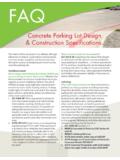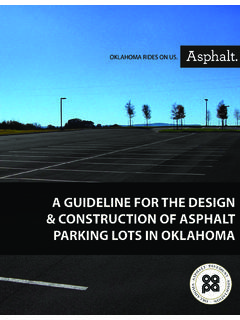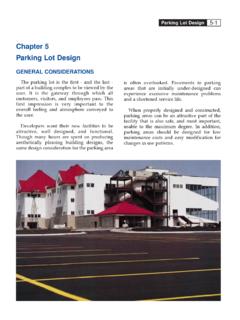Transcription of Shedding Light on Shedding Light on - Concrete Parking
1 Shedding Light on Shedding Light on Concrete s ReflectivityConcrete s Reflectivity Technical Fact Sheet Prepared by The National Ready Mixed Concrete Association Typical Concrete has a higher reflectance value than asphalt, along with a smoother, more reflective texture. The higher reflectance values from Concrete play as much of a role in the visibility and apparent brightness of the site as the lighting. US Department of Energy Shedding Light on Concrete s ReflectivityShedding Light on Concrete s Reflectivity Illuminance, Luminance and Concrete Pavement In simplest terms, illuminance is the amount of actual Light that strikes a surface. The density of the illuminance is measured in foot-candles (lumens per square foot, abbreviated fc), and is directly related to the proximity of the Light source to the surface.
2 Luminance is the Light that is reflected by a surface, or transmitted through it, in the direction of the observer. Measured in candelas per square foot (cd/ft2), luminance is directly related to illuminance, factoring in the reflectivity of the surface. Due to its lighter color and uniform surface texture, the high reflectivity of a Concrete pavement provides greater luminance than other typical pavements. In fact, studies show that a Concrete pavement s average luminance is times higher than asphalt. Concrete uses fewer luminaires, less energy* In a 2005 study, lighting installations for Parking lots were evaluated comparing Concrete and asphalt surfaces. Calculating a standard Light -ing design for a 53,800 ft2 Parking lot with single and quad 400 watt luminaires, a total of 22 luminaires provided an average luminance of.
3 315 cd/ft2 on the asphalt Parking lot. Calculations for the Concrete lot took into consideration the surface reflectivity, with the requirement that any change to the design would provide geometric symmetry for the lighting while targeting the benchmark of .315 cd/ft2 average lumi-nance. Four different configurations provided average luminance of .320 cd/ft2 to .326 cd/ft2 with as few as 14 luminaires. The reduction in luminaires would not only result in a lower construction cost, but also an average savings of 5,844 kW-hr annually, a reduction in energy requirements. Further calculations showed that compara-ble luminance could also be achieved on the Concrete Parking lot with a reduction in illuminance. In fact, if the wattage in each of the 22 luminaires on the Concrete lot was reduced from 400 W to 250 W, the average luminance of.
4 336 cd/ft2 was still greater than the original design with asphalt pavement. The reduction in watt-age equates to an average annual savings of 6,027 kilowatt hours. That is a reduction in energy requirements per year! By using Light emitting diodes (LED s), the wattage could be even further reduced to as little as 125W! *SN2458, Influence of Pavement Reflectance on Lighting for Parking Lots (Portland Cement Association, Skokie, IL, 2005) The Energy Independence and Secu-rity Act of 2007 (EISA 2007) mandates specific measures related to energy re-duction that apply to all federal agencies. Among the requirements for federal fa-cilities are: 25% greater efficiency for Light bulbs, to be phased in from 2012 to 2014 200% greater efficiency for Light bulbs, or similar energy savings, by 2020 All new and renovated federal build-ings must implement 55% reduction in fossil fuel use by 2010 and 80% reduction by 2020 By combining the leading-edge technol-ogy in energy efficient lighting with the superior reflectivity of Concrete , owners and developers can easily achieve these goals.
5 One side note to LED lighting is that efficacy is much lower despite their considerably lower energy consump-tion. As a result, LED lighting may not appear as bright to the eye as tradi-tional lighting. However, a recent US Department of Energy (DOE) study at the Leavenworth, KS Wal-Mart demon-strated that when used in conjunction with Concrete pavement, LED efficacy is improved. Surveys of Wal-Mart cus-tomers and employees indicated that the luminance of the LED-lit Concrete Parking lot was acceptable, even though it has significantly lower illumi-nance than a similar asphalt lot with a traditional 1000W metal halide lighting design. The DOE reported, Typical Concrete has a higher reflectance value than asphalt, along with a smoother, more reflective texture.
6 The higher reflectance values from Concrete play as much of a role in the visibility and apparent brightness of the site as the lighting. You can read the entire report at.





